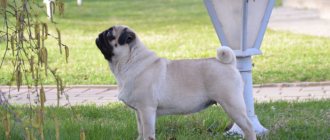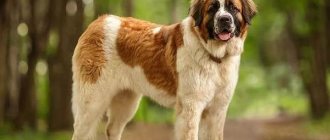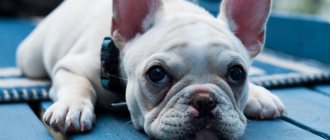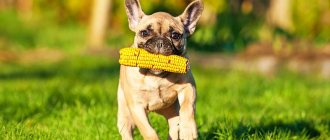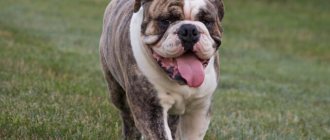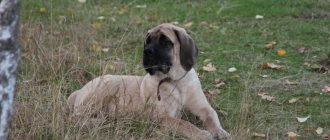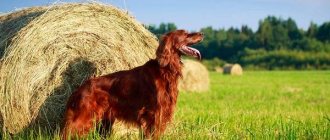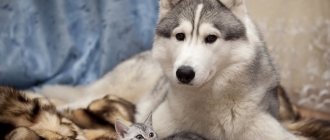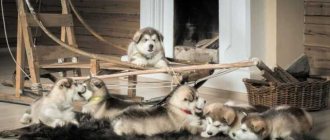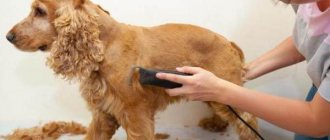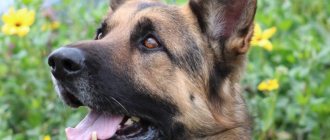The pug is one of the most ancient breeds with an interesting history. These small funny dogs have long been kept by representatives of the Chinese nobility. And now the popularity of pugs is not decreasing. This dog will not be a guard or protector, but he will become a devoted companion and cheerful friend for a child. His funny face with smart, serious eyes and calm character won the hearts of many dog lovers.
- Pugs sizes
- Feeding pugs
Breed traits
Breed traits (on a 5-point scale)
| Pug | |||
| Activity | in the house | 2.7 | |
| on the street | 3.2 | ||
| Obedience | training | 3.1 | |
| strangers | 3.4 | ||
| Domination | in family | 1.6 | |
| over dogs | 2.2 | ||
| Defending your territory | from people | 1.6 | |
| from dogs | 2.1 | ||
| Sociability | in family | 4.4 | |
| with strangers | 4.2 | ||
| with dogs | 3.6 | ||
| Concentration | in family | 1.4 | |
| in front of strangers | 1.4 | ||
| with dogs | 1.5 | ||
| Aggressiveness | in family | 1.2 | |
| to strangers | 1.3 | ||
| to the dogs | 2 | ||
| to cats | 1.9 | ||
| Family behavior | calmness | 3.8 | |
| demand for affection | 4.4 | ||
| excitability | 4.2 | ||
| playfulness | 4.3 | ||
| excessive barking | 2.4 | ||
| behavioral breakdowns | 1.8 | ||
| Tolerance for children | up to 4 years | 4 | |
| over 4 years old | 4.3 | ||
| Institutional use | watchman | 3.5 | |
| bodyguard | 1.2 | ||
This breed is often compared to the following dog breeds: Pomeranian, Pembroke Welsh Corgi, Yorkshire Terrier, French Bulldog, Pekingese.
Relationships with other animals
Pugs get along well with other dogs, cats and other animals. But, as in the case of children, the dog needs to be given enough attention so that he does not become jealous or start a rivalry.
Photo: krasivosti.pro
Scottish Fold cats: description, character and care
History of the breed
These small dogs have been living next to humans for more than 3,000 years. The first images and mentions of them in history date back to the 6th century BC. e. - at that time they were getting divorced in China and living in the palaces of the nobility. The Chinese saw hieroglyphs in the folds on the foreheads of these dogs, considering this an imperial sign. Therefore, they often lived better than ordinary people: they had their own rooms and servants. Ancient pictures show that they were carried on stretchers to prevent overwork.
Pug face
In China, these dogs were described as square, low, with a short muzzle, they were short-haired, unlike the long-haired ancestors of the Pekingese. Pugs were highly valued and expensive. They appeared in Europe in the 16th century and rich people also began to keep them. Many pictures of noble ladies holding such a pet on their laps have survived to this day. It was believed that they loved pug dogs because of their wrinkled face, which made them look like monkeys.
Gradually the breed spread to Europe. Pugs were first bred in Holland, then they were brought to Great Britain, France and other countries. But in the 18th century they became no longer so popular; they were started by merchants, merchants and even ordinary people. Therefore, pugs were in danger of degeneration. When, in the second half of the 19th century, Queen Victoria wanted to have this cute pet, she could not find a purebred puppy, so these dogs were again imported from China.
They began to be bred in Great Britain, and by the end of the 19th century the first mops club appeared. At the same time, a breed standard was created. Unlike Chinese dogs, European dogs have become short-legged, powerful, with a short nose, and larger in size.
These dogs came to Russia only at the beginning of the 20th century. But because of the revolution and two wars, no one dealt with them. Only in the 80s of the 20th century were the first pugs from the GDR brought to Moscow. After this, their breeding began. Over the past few years, the pug has been one of the most popular decorative breeds all over the world.
You can watch the video in more detail about the pug breed:
Color variations
The breed standard allows the following color options:
- black – completely black coat without interspersed hairs of light or white color;
- beige or apricot - wool of warm shades from cream to golden;
- silver is a coat of a cool light gray shade that does not turn into white.
For dogs of apricot and silver color, it is mandatory to have a dark mask on the face.
Description of the breed
The Pug dog is an ideal companion and one of the few breeds that are suitable for keeping in an apartment. They are owned by older people, families with children, because such pets have a calm, balanced character. They live well next to both children and old people, and get along with other pets. Their cheerful, playful nature and funny face attract many. But representatives of the pug breed are quite lazy, so they are more suitable for inactive owners.
Pug eyes
Pugs have a very recognizable appearance. This is a squat dog with an almost square body and a flattened muzzle with an abundance of folds. She has wide-set, round, intelligent eyes and a distinctive gait. Despite the apparent clumsiness of the dog, it is springy and elegant. When moving, the back of the body rolls and the forelimbs push off.
Before you decide to get a pug dog, you should study its characteristics and know its advantages and disadvantages.
| Options | Characteristic |
| Aggressiveness | Not aggressive at all, calm |
| Friendliness | Very friendly, sociable, gets along with everyone |
| Attitude towards the child | Loves children, plays with them, treats them with care |
| Intelligence | Smart, inquisitive, quick-witted, with a good memory |
| Training | Can easily understand simple commands, but can be stubborn |
| Attitude towards loneliness | Cannot stand it, becomes very attached to the owner, follows him everywhere |
| Security qualities | Short, friendly to strangers |
| Shedding | Frequent, causes allergic reactions |
| Health | Prone to obesity, eye diseases, breathing problems |
| Care | Easy to use, suitable for beginners |
| How long should you walk? | Less than an hour a day |
| Conditions of detention | Any, adapts to life even in a small apartment |
| Lifespan | 10-15 years |
pros
Pug face
Many people find the appearance of pugs repulsive due to their flattened muzzle and abundance of folds. But in reality they are very cute, which can be seen even in the photo. In addition, they have many advantages:
- they love children very much, they can become a friend for a child;
- loyal to the owner, follow him everywhere, support him in everything;
- smart, easy to train;
- calm, flexible, friendly to guests;
- they have no aggression at all, they hardly bark;
- they are not picky, live quietly in any conditions, and their small size allows them to be kept in a city apartment;
- easily adapt to the owner’s lifestyle;
- it is not necessary to walk for a long time;
- Caring for pugs is simple, so they are suitable even for inexperienced dog owners.
Minuses
But still, the pug is not an ideal breed; it has disadvantages:
- some dogs are stubborn and disobedient;
- clumsy and lazy, they get tired quickly, so they are not suitable for active people;
- often become attached to one person and can be jealous;
- not suitable for the role of a security guard;
- sleep a lot, like to climb onto the sofa or into bed, and snore in their sleep;
- they shed twice a year, hair loss is very active, because of this, pugs are often allergic;
- prone to weight gain and allergies, so you need to watch your diet;
- They cannot tolerate heat and freeze quickly in cold weather, so in winter they need clothing.
To decide whether to get a pug dog, you can watch the video:
Pet breeding
A female dog's first heat begins at 6-10 months, but a dog cannot be bred at this age - she is not yet ready to bear healthy offspring.
The minimum age suitable for breeding a pug is 15 months .
Mating takes place 10-13 days after the start of estrus in the male dog’s territory and is repeated after 2-3 days to increase the likelihood of fertilization.
Before mating, the bitch must be prepared:
- she must have all her vaccinations;
- 3-4 weeks before the expected date of mating, carry out deworming;
- bring the pet’s weight back to normal: she should not show signs of obesity or exhaustion.
NOTE!
Pregnancy lasts 63 days, it can be determined by the behavior of the bitch: she gains weight, becomes less active, and sleeps a lot.
There is a possibility that the dog will not be able to give birth on its own and will need a caesarean section, which must be taken into account in advance and try to ensure that the entire pregnancy proceeds under the supervision of a veterinarian.
Standard
Pugs, according to the standard, belong to the decorative and companion breeds. They are classified as small molossoids; among small dogs they are closest to mastiffs. The fact that they have a powerful physique can be seen from any photograph.
Pugs sizes
From the photo of the pug you can tell that this is a small dog. The female’s height is 25-30 cm, weight – up to 8 kg. Males are 30-35 cm tall and can weigh from 6 to 10 kg.
Color options
The most common colors of pugs are beige, apricot, and platinum. The first pugs in Europe were exactly like this. And until the end of the 19th century, other colors were not recognized, and the black color was considered a defect and such puppies were destroyed. Nowadays the black pug is becoming more and more popular.
Pug
Light colored dogs should have different patterns and markings. Most often this is a black mask on the face and ears, but there may be dots on the forehead or cheeks, a stripe along the back, and darker claws. Pure white color is a breed defect.
Wool
Pugs have short, shiny and smooth fur. It may be a little shorter on the muzzle. The coat is not hard, but not fluffy, and lies tightly to the skin. They shed twice a year, which is why many people experience allergies.
Head
Pug dogs have a large, round head. In front it is covered with folds, which are a characteristic feature of this breed and form a special symmetrical pattern. But they are located mainly on the forehead, and do not hang down on the sides of the muzzle.
Pug ears are small and triangular. Previously, they were docked, but since the end of the 19th century this has been abandoned. Therefore, the ears can either hang down, covering the auricle, or open it a little.
Muzzle
A characteristic feature of pug dogs is their short, slightly flattened muzzle, similar to a bulldog. But they only have a small undershot; their teeth and tongue are not visible. The lower jaw is wide and straight.
The nose is not turned up, the nostrils are large. The bridge of the nose is short, straight, covered with a fold, and the nose is always black. The nasal passages are not crooked, so breathing problems are less common than in bulldogs.
Pug nose
When looking at the dog from the front, the muzzle should be flat and wide. It should not be upturned or down. Hanging folds and protruding lower jaw are unacceptable.
The pug's eyes are round, large, widely spaced, and located in line with the nose. They should not be light or too convex. They are characterized by a meaningful expression that changes depending on the situation. Looking at the photo, you can always understand what mood the dog is in. They can be sad, cheerful, mischievous or wise.
Torso
The Pug is a small but balanced dog. The body is muscular, stocky, compact. It should not be too thin or, on the contrary, thick. The dog's height should be approximately equal to its length. The skin is elastic and gathers into small folds.
The neck is thick, powerful, slightly curved with a pronounced scruff. The chest is quite wide. The back is straight and muscular.
Pug and cookies
Pugs have a short tail, curved into a ring. He is set high, so he almost lies on his back. According to the standard, a double curl of the tail is desirable.
Limbs
Limbs are straight and strong. They are parallel, located directly under the body. The feet are small and the toes are well separated. The gait is confident and springy. Joints with clearly defined angles.
Varieties
When breeding pug dogs, they try to preserve the breed characteristics. But now there are three varieties:
- terrier type – more graceful build, elongated neck;
- bulldog type - thick short legs, wide body, slightly protruding lower jaw;
- Shar Pei type is characterized by an abundance of folds throughout the body.
Vices
Some puppies are born with defects that do not meet the standard. Such dogs are not allowed for breeding and are considered a waste. Some of the defects do not affect the behavior and health of the dog. Therefore, she can still become a good friend to a person who does not care about documents. What deficiencies will not give you a pedigree:
- convex skull, protruding forehead;
- absence of the bridge of the nose, a large or small fold on it;
- upturned nose, inverted or narrow nostrils;
- hanging folds, especially on the cheeks;
- light-colored, small or close-set eyes;
- teeth or tongue visible when mouth is closed;
- disproportionate body - too elegant or fat, long neck, sagging breasts;
- The coat is long, fluffy, white in color.
What are the varieties?
In addition to the classic pug, there are other varieties of this breed:
- Lo-Sze (international name - American Lo-Sze Pugg). This variety was bred by Rebecca Mons in 1989. Visually, Lo-shis are almost no different from standard pugs, but have more compact sizes. So far, this new low-growing species is only recognized in the United States;
- Mini Pugs. This species is characterized by short stature and short legs. This variety does not officially exist, but in large litters you can often find a puppy with pituitary dwarfism (a genetic disease) that will remain small forever. Dwarf pugs are more popular than their standard cousins and sell for a higher price;
- Terrier and bulldog type pug . This type of pug is the result of a genetic failure. A characteristic feature of this type is an elongated neck - longer than required by the standard. Such dogs are distinguished by their wide and powerful chest and special paw placement.
Character
The main character traits of pugs are friendliness and calmness. These cute dogs are unobtrusive and balanced. Most of the time they just sleep. They love to do this next to their owner on the couch.
But only adult dogs are lazy, and even then, they are always ready to play. Pug puppies are energetic and playful. They are cheerful, active, chasing leaves or snowflakes. Up to 2-3 years old, pugs love to frolic. But gradually they become more calm and restrained.
They are affectionate and loyal, they get very bored without their owner, so it is not advisable to leave one pet for a long time. These dogs are friendly with all family members. Warm feelings are shown by caressing and wagging the tail, even towards guests and strangers. This can lead to problems, so you immediately need to teach the dog not to obey strangers and not to take food from their hands.
Photo of a pug
The pug is a good companion for people of any age. He is able to amuse with his mischievous antics and funny facial expressions, and brighten up the loneliness of an elderly person. They are bad guards, but still the pet will always warn the owner about the arrival of a guest with his barking. And if someone threatens family members, he will bravely rush to defense.
One of the characteristics of the breed is that these dogs love children. The pug will become a devoted friend and nanny for the child, accompany him everywhere and tolerate his pranks. But it is worth keeping an eye on their play so that the baby does not injure the pet.
Another characteristic of the Pug breed is its stubbornness and perseverance. They are smart and quick-witted, so they easily show their owner what they want. For this same reason, they can be difficult to train, especially as adults. This dog may refuse to follow a command if it is offended, tired or believes that it does not need it.
Popular colors
There are four main types of color:
- classic black;
- beige-brown color of various tones (“fawn”);
- beige color with apricot tint (“sunlight fawn”, “apricot”);
- beige-brown color (“moonlight silver fawn”).
Education and training
Raising a pug should be done from the first days of its appearance in the house. These dogs are easy to teach to go to the toilet in a diaper or in a special litter box. They quickly understand simple commands. Proper upbringing in the first 6 months will make life much easier for the owners later. After all, a pet that is not raised properly will become stubborn and uncontrollable.
But more advanced pug training can be challenging. These dogs are stubborn, smart, and have a developed sense of self-esteem, so it is not permissible to raise your voice or even hit your pet. When training, only encouragement works. The pug quickly understands that a treat awaits him for correctly executed commands. It’s just not recommended to give them often, so as not to require treatment for obesity, it’s better to praise and caress.
Mating
Pugs are small dogs, but they can be difficult to breed due to their unusual plump build. To resolve this, you can invite a trained person to show and tell the owner what to do.
Typically, Pugs mature at 8-10 months of age. Mating is allowed only from 20 , when the bitch goes into her third heat. The girl is brought to the territory of the male dog, where the pets must meet and sniff. The female will allow you to mount if everything went well. The owner must support her under the belly and behind the head, while the male dog is directed into the noose. The act will last 10-12 minutes , the castle may not take place. If the lock is delayed, the pets need to be turned into a comfortable position.
After mating, the male needs to be fed, the female needs to be calmed down and allowed to rest. After two days, re-mating is prescribed. To track the progress of pregnancy, you can contact your veterinarian or an ultrasound center for animals.
A couple of black pugs in the photo
Caring for Pugs
For a dog to live longer than 10 years, it needs to be well cared for. This is easy even for inexperienced dog owners. You need to regularly trim your nails, clean your ears and teeth.
Skin folds require special care. Once a week they need to be cleaned with a cotton pad soaked in boiled water or a special lotion. You need to bathe your pet once every 2-3 months. After each walk, wipe or wash the paws, as well as the fur if the dog was without clothes.
The eyes of these dogs are susceptible to various diseases. Therefore, you need to protect them from dust and not allow your pet to run through tall grass. Often, owners have to treat conjunctivitis in their pet with special drops.
Pug and French bulldog
Grooming is easy. Only during shedding does it need to be brushed daily to speed it up. The rest of the time, brushing once a week is enough. If the hair falls out, you need to take your pet to the veterinarian.
When purchasing a puppy, you need to find out how long you will have to walk him. It is recommended to take a small pet out 4-5 times a day; an adult animal is taken out 2 times. Try not to walk for a long time in the heat, and in winter, dress your pet in clothes.
Feeding pugs
The owner needs to strictly monitor the diet of these dogs, as they have a good appetite. If you feed pugs incorrectly, they will develop obesity. It is especially important not to give treats and pieces from your table too often. The pug is suitable for both natural food and dry food. The main thing is to determine how many times a day to feed him and in what volume.
A pet is fed 4 times from 3 to 7 months, then up to a year - 3 times, an adult dog eats twice a day. If she is breastfed, the diet should include meat, vegetables, cereals, and dairy products. But it is difficult to create a balanced diet from such food, so these dogs are often switched to dry food. It's easier, especially since there are feeding tips on the packaging.
It is recommended to choose super-premium or holistic food for pugs. They contain all the necessary nutrients and vitamins.
Diseases
These dogs have several specific diseases. To get rid of some of them, no special treatment is required, only more careful care and proper nutrition.
- These pets often snore in their sleep. During physical exertion they may grunt and wheeze. This is due to the special structure of the nasal passages. It is necessary to ensure that the pet does not become overtired or overheat.
- Pugs are prone to weight gain. Obesity develops quickly, especially if you feed your pet natural food and give it scraps from the table.
- Often in representatives of this breed the fold above the nose becomes inflamed. It is recommended to wash it with Chlorhexidine solution and be sure to dry it well.
- These pets are prone to dental diseases, tartar formation, and curvature. Therefore, it is recommended to choose the right food.
- There is also a disease such as chronic corneal erosion. It should be treated under the guidance of a doctor: vitamins, antibiotics, and iodine preparations are used.
- With improper feeding, allergies often develop. It can be either natural food or dry food.
For more information about keeping pugs and how to care for them, watch the video:
Owner reviews
“It’s difficult to raise a pug because he has a very sad look. That's why our Peach is allowed everything. It is impossible to calmly eat food - he will look you in the eye, beg with his paw, and climb onto the table despite commands.
Pugs are very kind, ours pesters everyone on the street: cats, dogs, people, although not everyone likes it.
He loves to catch air in the car, when you turn on the hairdryer, or when you blow on him, so to speak, a plug.
He tries to lick everyone, gets in everyone’s face.
He picks up all sorts of nasty things from the floor and eats them, running away so that they don’t take them away. Our Peach loves to eat everything, especially sweets, even though he’s not allowed to. He enjoys stealing candy.
If he needs to wake me up, he will jump and walk on me with all his heavy weight, lick my ears and face, which is impossible to tolerate.
Overall a very cheerful, active dog. We thought he would be lazy, but he’s not.”
Alina Golovina, Gomel.
“We bought our pug when he was 4 months old, they say this is a big age for dogs, but we fell in love with him at first sight. He was quiet and the most modest of them all. However, he showed himself at home and ran very actively!
We didn’t punish him, and he began to play dirty tricks, you know, like children who are allowed to do everything. One day he ate my expensive shoes, and I brutally kicked him in the backside. I was wrong, it was my big mistake, he needs to buy toys from childhood. And now he doesn’t recognize either toys or shoes. He has become very grown up.
We lived in such a way that he did not play with other dogs, and as a result he is an antisocial dog. He knows only us and no one else. In the city he is afraid of everyone and does not want to communicate with his relatives. But he knows all his family and friends by name, loves us all until he screams in his throat. If we suddenly go on vacation, he suffers a lot, and we talk to him on the phone and persuade him to eat. He always sleeps with us, he loves us under the covers, like a little son.
He chose me to be in charge right away, probably punishing me severely! Pugs are very smart, they understand everything. And you know, this is the most devoted friend. I adore him and love him madly!”
Ksenia Perovskaya, Moscow.
How to buy a puppy
If you decide to purchase a pug puppy, you need to contact a kennel. The cost of a dog there will be higher than from the hands, but there is a guarantee that the pet will be purebred. The price of a pug can be from 15 to 45 thousand rubles. It depends on the color, the pedigree of the parents, and the fame of the nursery.
Enjoy Your Bath…
Before choosing, it is recommended to study photos and reviews of breeders. When purchasing, you need to carefully examine the puppy. He should be healthy, cheerful, active.
The owners of these amazingly charming and playful animals describe them only in positive terms. This pet will become a devoted friend and a constant source of positivity. With proper care and feeding, he will delight all family members for a long time with his positive character and friendliness.
Kinds
The Pug dog has no officially recognized varieties. But as a result of genetic failures, anomalies, and crossings with other breeds, puppies appear that many animal lovers dream of acquiring.
Dwarf (couch) pugs. The appearance of a “toy” puppy is associated with a large number of puppies in one litter. Caring for the baby requires special efforts from breeders, since the mother cares more about healthy babies. The mini pug can grow up healthy in the future. Another option for the development of the baby is that a disease associated with cessation of growth will appear.
Mixture with Chinese Crested. The result was amazing - a hairless dog with woolly tufts and rough skin.
French pug. Appears from crossing a French bulldog and a pug. Mixed breed does not represent a separate type of dog; the name is sometimes misleading.
All puppies from different breeds are unique. The result is unpredictable, one of a kind. The color range is wide, rich in shades. Breeders believe that light fur goes to pugs who are calm in nature, while dark fur goes to playful puppies. The color factor can be taken into account when choosing a pet for family members. will suit the most active person , a cream shade will suit the sloth.
Dogs that outwardly resemble the appearance of a decorative dog are mistakenly recognized as relatives of the pug:
- English Mastiff;
- French bulldog;
- Pekingese
The small size, flattened face, and folds on the forehead cause confusion for non-specialists.
Health
Outwardly strong pugs have been given a large supply of health by nature, but they also have their pitfalls.
The former are related to the physiology of the breed, the latter relate to genetic problems.
By paying more attention to the pet, the owner will feel one hundred percent return in his love and devotion!
Characteristic diseases
A dog's eyes are designed in such a way that they are prone to frequent injuries, and with a strong blow to the head, the eyeball may fall out.
Don't try to fix it yourself, cover the eye with a patch and take your dog to the vet. The pug's eyes also suffer from the folds above them.
If the folds of skin hang too much over the eyelids, injury to the cornea occurs, which can lead to creatitis.
Plastic surgery to suturing the folds helps to avoid chronic disease.
Another hereditary disease is Perthes disease. It is expressed in aseptic necrosis of the femoral head and affects the animal at a young age.
The development of the disease leads to drying out of the limb. Surgery is necessary, and the sooner, the faster the puppy will get rid of lameness and will not lose a paw.
Due to the narrow ear canal, pugs suffer from frequent ear infections.
The structure of the dog's muzzle revealed another problem of the breed - short teeth, which are susceptible to caries and loss. They need to be cleaned regularly.
Juvenile demodicosis is also a hereditary disease of the breed.
An acarimorphic mite settles on the dog’s skin, turning the fur into a moth-eaten coat. Appears in puppyhood.
Ailments such as cataracts and allergies are rare.
The pug is a very active, energetic and purposeful dog.
Vaccinations
The pug vaccination schedule is the same as for all dog breeds.
The first vaccination is carried out at 2 months of age.
As a rule, a polyvalent vaccine is used that is effective against hepatitis, plague and enteritis.
Additionally, the vaccine may include preventive drugs against leptospirosis and adenovirosis.
Before each vaccination, the dog should be dewormed 10 days before the procedure.
Vaccination is repeated every year.
A cute face, soft ears, a cheerful disposition, a friendly character - this is a pug!
